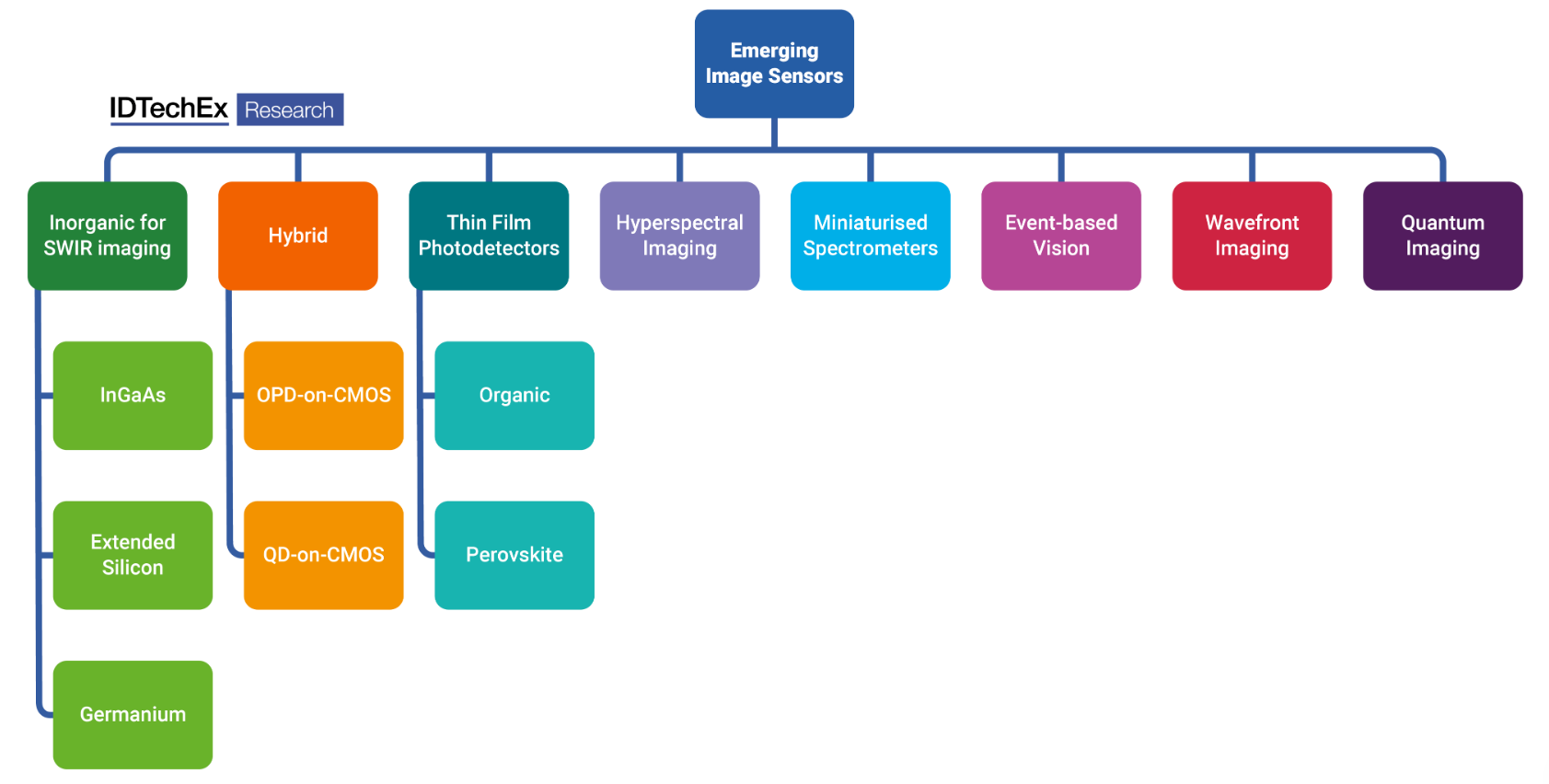The new IDTechEx report, “Emerging Image Sensor Technologies 2023-2033: Applications and Markets”, explores a diverse range of image sensing technologies capable of resolutions and wavelength detection far beyond what is currently attainable.
 Technologies covered the IDTechEx report “Emerging Image Sensor Technologies 2023-2033: Applications and Markets”. Source: IDTechEx
Technologies covered the IDTechEx report “Emerging Image Sensor Technologies 2023-2033: Applications and Markets”. Source: IDTechEx
Many of these emerging technologies are expected to make waves within numerous sectors, including healthcare, biometrics, autonomous driving, agriculture, chemical sensing, and food inspection, among several others. IDTechEx expects that the growing importance of autonomous technologies will lead the emerging image sensor market to over US$500 million by 2033.
Broadening Spectral Range
Conventional CMOS detectors for visible light are prevalent within robotics, industrial image inspection, and consumer electronics; however, there is extensive opportunity for more complex image sensors that offer capabilities beyond that of simply acquiring red, green and blue (RGB) intensity values. Extensive effort is currently being devoted to developing emerging image sensor technologies that can detect aspects of light beyond the visible range into the short-wave infrared (SWIR, 1000 nm – 2000 nm) range. Extending wavelength detection into the SWIR range presents many benefits as it enables the differentiation of objects and materials that appear visually similar or identical within the visible range. This substantially improves recognition accuracy and paves the way for better and more functional image sensing.
A particularly important trend is the development of much cheaper alternatives to very expensive InGaAs sensors for imaging in the short-wave infrared (SWIR, 1000 – 2000 nm) spectral region, which will open this capability to a much wider range of applications. This includes autonomous vehicles, in which SWIR imaging assists with distinguishing objects and materials that appear similar in the visible spectrum while also reducing scattering from dust and fog.
There are several competitive emerging non-InGaAs SWIR technologies. These include hybrid image sensors where an additional light-absorbing thin film layer made of organic semiconductors or quantum dots is placed on top of a CMOS read-out circuit to increase the wavelength detection range into the SWIR region. Another technology is extended-range silicon, where the properties of silicon are modified to extend the absorption range beyond its bandgap limitations. Currently dominated by expensive InGaAs sensors, these new approaches promise a substantial price reduction, and that is expected to encourage the adoption of SWIR imaging for new applications such as autonomous vehicles.
New Capabilities Enabled by Emerging Image Sensors
In addition to imaging over a broader spectral range, further innovations include imaging over a larger area, acquiring spectral data at each pixel, and simultaneously increasing temporal resolution and dynamic range. On this front, a promising technology is event-based vision. With conventional frame-based imaging, a high temporal resolution produces vast amounts of data that requires computationally intensive processing. Event-based vision resolves this challenge by presenting a completely new way of thinking about obtaining optical information, in which each sensor pixel reports timestamps that correspond to intensity changes. As such, event-based vision can combine greater temporal resolution of rapidly changing image regions with much-reduced data transfer and subsequent processing requirements.
Another promising innovation is the increasing miniaturization and conformality of sensor technology, making it easier than ever to integrate a sensor into a robotic arm, industrial inspection machinery, or consumer electronics. These are an application the burgeoning market of miniaturized spectrometers is targeting. Driven by the growth in smart electronics and Internet of Things devices, low-cost, miniaturized spectrometers are becoming increasingly relevant across different sectors. The complexity and functionalization of standard visible light sensors can be significantly improved through the integration of miniaturized spectrometers that can detect from the visible to the SWIR region of the spectrum with high spectral resolution. The future being imagined by researchers at Fraunhofer is a spectrometer weighing just 1 gram and costing a single dollar. Miniaturized spectrometers are expected to deliver inexpensive solutions to improve autonomous efficiency through enhanced material, object, and color differentiation.
- What technology readiness level are these emerging image sensing technologies at?
- What disruptive technologies are on the horizon?
- Which companies are exploring emerging image sensing technologies
- Which applications are expected to benefit the most?
- How can autonomy be improved by image sensors?
- What are the difficulties in commercializing these emerging technologies?